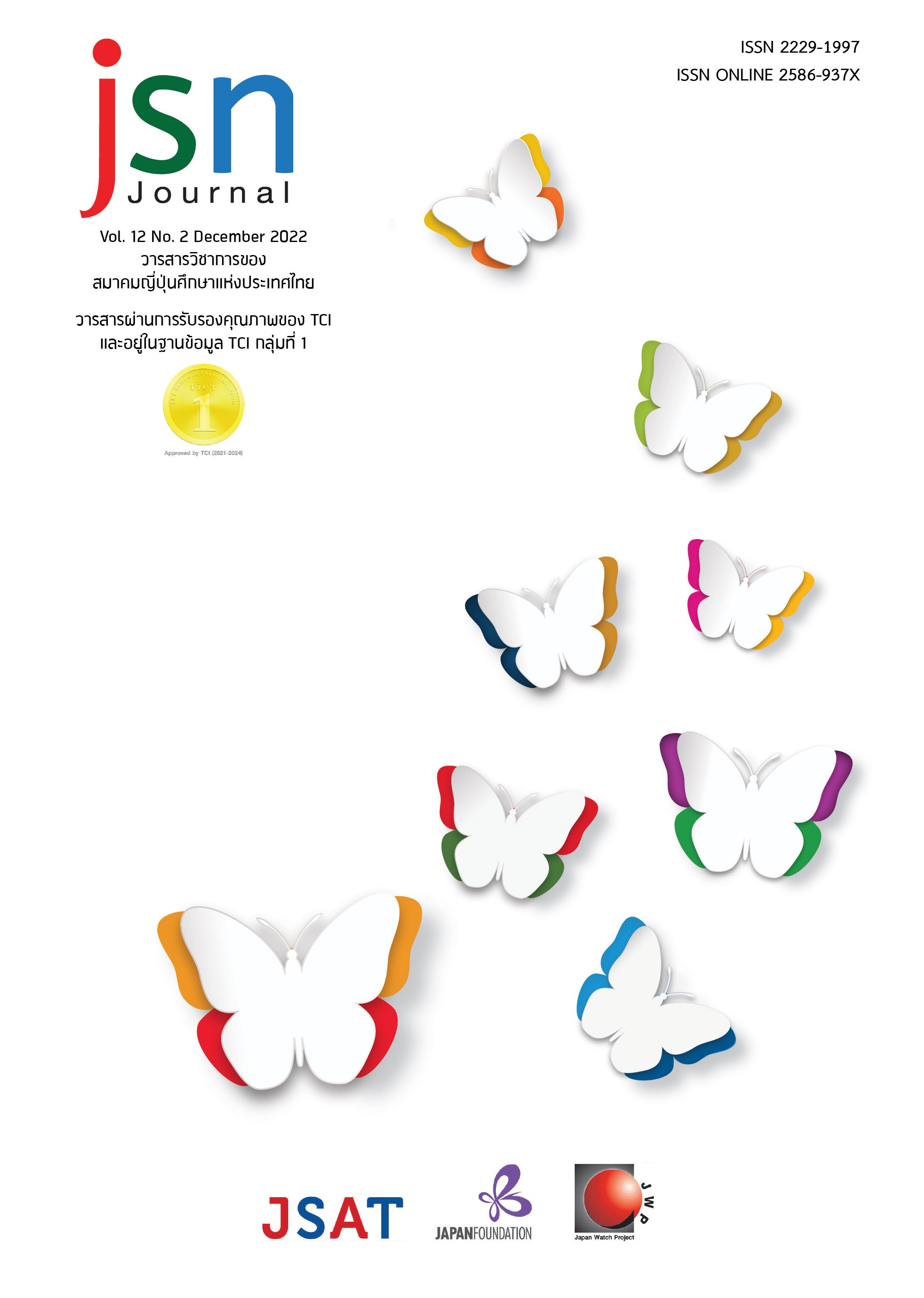The Evaluative Reading of Japanese Compositions among Thai Students Majoring in Japanese An Analysis of Schema Regarding Japanese Composition
Main Article Content
Abstract
The objectives of this research were to investigate the criteria that Thai students majoring in Japanese use in evaluating Japanese compositions written by others and to analyze their schema or background knowledge regarding Japanese composition. The participants were asked to evaluate the pros and cons of three Japanese compositions. The results showed that most of the participants evaluated the compositions by using content, structure, and the use of Japanese as the criteria, reflecting their schema in those three main areas. In terms of sub-criteria analysis, it was found that the participants clearly recognize the following: 1) the appropriate use of Japanese, especially Japanese vocabulary and the length of the sentences; 2) the writing of clear and concrete supporting sentences; and 3) the organization of paragraphs into the introduction, body, and conclusion. The schema that should be emphasized the most in teaching Japanese composition is the unity of content and the continuity of the content between paragraphs. The findings concerning the evaluative reading criteria and the schema about Japanese composition revealed the factors that Thai learners of Japanese pay or do not pay attention to when writing Japanese compositions, which is useful information for the development of Japanese composition writing skills.
Article Details

This work is licensed under a Creative Commons Attribution-NonCommercial-NoDerivatives 4.0 International License.
ข้อความและข้อคิดเห็นต่างๆ ในบทความเป็นของผู้เขียนบทความนั้นๆ ไม่ใช่ความเห็นของกองบรรณาธิการหรือของวารสาร jsn Journal
References
กุลรัมภา เศรษฐเสถียร. (2565). ปัญหาการเกาะเกี่ยวความในเรียงความภาษาญี่ปุ่น: กรณีศึกษาผู้เรียนวิชาเอกภาษาญี่ปุ่นชาวไทย. วารสารเครือข่ายญี่ปุ่นศึกษา. 12(1), 174-196.
สมเกียรติ เชวงกิจวณิชและชิซุกุ ยานางิซาวะ. (2560). เทคนิคพื้นฐานการเขียนเรียงความภาษาญี่ปุ่น. กรุงเทพฯ: สมาคมส่งเสริมเทคโนโลยี (ไทย-ญี่ปุ่น).
Carrell, P.L. (1987). Content and Formal Schemata in ESL Reading. TESOL Quarterly, 21(3), 461-481.
Carrell, P.L. & Eisterhold, J.C. (1983). Schema Theory and ESL Reading Pedagogy. TESOL Quarterly, 17(4), 553-573.
Fitzgerald, J & Shanahan, T. (2000). Reading and Writing Relations and Their Development, Educational Psychologist, 35(1), 35-50.
因京子・村岡貴子・仁科喜久子・米田由喜代 (2008).「日本語テキスト分析タスクの論文構造スキーマ形成誘導効果」『専門日本語教育研究』10, 29-34.
因京子・山路奈保子 (2009).「日本人学部1年生の論文構造スキーマ形成過程の観察」『専門日本語教育』11, 39-44.
国際交流基金a (2010).『国際交流基金 日本語教授法シリーズ 第8巻く「書くことを教える 」』株式会社ひつじ書房.
国際交流基金b (2010).『国際交流基金 日本語教授法シリーズ 第7巻く「読むことを教える 」』株式会社ひつじ書房.
田中真理・阿部新 (2014).『Good Writingへのパスポート―読み手と構成を意識した日本語ライティング―』くろしお.
田中真理・坪根由香里 (2011).「第二言語としての日本語小論文におけるgood writing 評価―そのプロセスと決定要因」『社会言語科学』14 (1) . 210-222.
坪根由香里・田中真理 (2015).「第二言語としての日本語小論文における『いい内容』『いい構成』を探る―評価観の共通点・相違点から―」『社会言語科学』18 (1) . 117-127.
坪根由香里・トンプソン美恵子・影山陽子・数野恵理 (2021).「第二言語としての日本語ナラティブ作文の評価基準とリーブリックの開発」『大阪観光大学研究論集』21, 85-94.
中村かおり (2020).「日本語学習者の形式スキーマ形成を目指したライティング指導―文章構造分析タスクを用いた授業実践から―」『拓殖大学日本語教育研究』5, 71-95.
村岡貴子・因京子 ・仁科喜久子 (2009).「専門文章作成支援方法の開発に向けて:スキーマ形成を中心に」『専門日本語教育』11, 23-30.
望月雅美 (2021). 『どう教える? 日本語教育「読解・会話・作文・聴解 」の授業』アルク.


